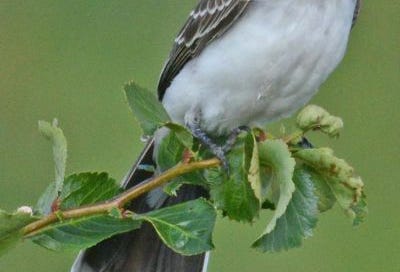September: Eastern Kingbirds
The scientific name for our bird this month is Tyrannus tyrannus—the Latin word “tyrannus” being the root of the English word “tyrant” and carrying with it meanings of lord, master, monarch, and despot.
Oh my. What kind of a bird could this be, then, being doubly-named tyrannus?
Well, for starters, the eastern kingbird is not a big bird; in fact, it is slightly smaller than an American robin. So, if the idea of a “tyrant bird” brought to mind thoughts of a massive, imposing, bird-of-prey-like creature, imagine this instead: eastern kingbirds are sturdy, straight-backed, confident-looking birds with large black heads, short black bills, charcoal-gray bodies, white undersides, and a wingspan of just 13 to 15 inches. Instead of monarch’s robe, these birds have long, regal tails tipped with dazzling white. More than a robe, eastern kingbirds also have a hidden crown—a patch of yellow, orange, or red feathers atop its head that stand up and are seen only when in defense-mode or when performing courtship displays.
Eastern kingbirds belong to a family of birds known as tyrant flycatchers. The family name is derived from the eastern kingbird itself, which was first described as a “tyrant” by a naturalist in the 1730s.
Like any tyrant, then, eastern kingbirds are aggressive. Common in semi-open habitats, they like to keep a lookout for danger from high places, like utility lines and fence posts. They defend their territories by attacking much larger animals who get too close, such as hawks, herons, crows, and squirrels. Eastern kingbirds will also fight each other in territorial disputes, locking feet in midair and pulling out the other’s feathers. Additionally, they do not hesitate to knock birds, such as bigger and heavier blue jays, off branches to maintain their space. If other birds, including other eastern kingbirds, parasitize their nests by laying eggs in them, female eastern kingbirds will detect the imposters in their brood and expel them.
Eastern kingbirds are insectivores during breeding season and snatch out of the air or from foliage any number of insects, including beetles, wasps, flies, bees, locusts, moths, and dragonflies. They’ll also occasionally eat small frogs and rodents. They prefer to eat larger insects, which they smack senseless against a tree before devouring whole (minus any stingers). Like other birds that are insectivores, eastern kingbirds regurgitate the exoskeletons of insects they ingest.
Eastern kingbirds may not be monogamous in that there are often more males than females; so, a female may have more than one mate. In courtship displays, males impress their intended mates by performing “aerial acrobatics.” Females take 7 – 14 days to build their nests and another 14 – 17 days to incubate the eggs. Nestlings are in the nest for about the same length of time as the eggs were incubated, and once young leave the nest, their parents continue to tend to them for about a month.
The aggressiveness and attentive parenting of eastern kingbirds pay off in the high survival rates of their broods. Families of eastern kingbirds may stick together until fall migration.
Eastern kingbirds are in the same taxonomic group as songbirds, but they lack the complex vocalizations characteristic of true songbirds. Their calls are often described as “metallic,” “stuttering,” “kittering,” or “twittering.” Also unlike true songbirds, who typically migrate by night, eastern kingbirds migrate by day. They are long-distance migrants, taking plenty of stops along the way.
While “kingbird” is a perfectly fitting title, the word “eastern” in its name may be something of a misnomer. Eastern kingbirds breed throughout much of the United States and Canada—not just eastern portions—save for far northern reaches of Canada and the western and southwestern U.S. While more-or-less solitary couples during breeding season, they migrate in large flocks, even thousands, most often to the western Amazon region of South America for the winter.
In breeding season, eastern kingbirds seek out habitats that have a combination of wooded areas for their nests and open areas for catching food, especially along water and wood edges like farmland, orchards, and roadsides, gravitating toward trees like Osage-orange, apple, elm, mulberry, and spruce. They winter in tropical lowlands and will pause during their migratory journeys in any number of accommodating habitats like parks, golf courses, or a backyard near you.
Since the diets of eastern kingbirds shift during non-breeding season to mostly fruit, you may have a better chance of spotting one during a migratory layover in places where they are welcomed by an abundance of mulberries, cherries, blackberries, or other small fruits that they eat throughout the fall and winter. After all, a king likes a delicious snack once in a while, too.
Sources:
https://www.allaboutbirds.org/guide/Eastern_Kingbird/id
https://www.audubon.org/field-guide/bird/eastern-kingbird
https://ebird.org/species/easkin
https://abcbirds.org/bird/eastern-kingbird/
https://www.bird-sounds.net/eastern-kingbird/
https://en.wikipedia.org/wiki/Tyrant_flycatcher



